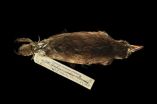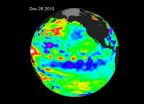Cattle health and welfare at the heart of K-State research
2011-01-14
(Press-News.org) MANHATTAN, KAN. -- At any given time between 10 and 20 percent of cattle in the United States are afflicted with lameness, making it one of the most common ailments affecting feedlot and stocker calves.
That's why a Kansas State University research team is working to reduce the percentage of cattle affected by bovine lameness.
Three researchers -- David Anderson, professor of clinical sciences; Brad White, associate professor of clinical sciences; and Johann Coetzee, associate professor of clinical sciences -- are involved with bovine pain and welfare assessment at K-State's College of Veterinary Medicine. Because of their efforts to understand and treat lameness in cattle, they are becoming leaders in this critically important bovine research.
"K-State is one of the few universities in the country with a farm animal surgery program," Anderson said. "Because of the research we're doing here, we're getting national and international attention about these programs."
The team is developing a model to assess lameness and identify possible ways to treat it. Lameness can be excruciatingly painful for cattle and is caused by a variety of factors, including nutrition, environment and infectious organisms, Anderson said. When damage to the hoof and sole results in ulcers, abscesses or infection of the deep tissue of the foot, it causes severe pain during weight bearing.
The goal of their research is to identify risk factors for the prevention of lameness, validate tools for early detection, develop recommendations for effective treatment, and ultimately improve the health and welfare of cattle. Each researcher is focusing on a different area of the project.
Anderson is working on pressure map technology, which is a way of measuring the weight bearing and method of stride. White is working on accelerometry, which involves using monitors to measure the behavioral responses of animals. White can monitor an animal for 24 hours to determine how much time it spends lying down, moving around or standing still.
Coetzee, a pharmacokinetic and pharmacodynamic specialist, is working to analyze indicators of pain in the blood and analyzing drugs to determine the dosage to reduce pain.
So far the researchers have developed ways to assess lameness. They are now looking at therapeutic models and identifying drugs -- such as flunixin and meloxicam -- that could help ameliorate pain and lameness.
The researchers recently published work on sodium salicylate in the Journal of Dairy Science and will have an upcoming article about flunixin in the American Journal of Veterinary Research, expected sometime in 2011.
Anderson spoke at the 2010 World Buiatrics Congress in Santiago, Chile, about farm animal surgery and has been invited to speak at the 2012 World Buiatrics Congress in Portugal.
INFORMATION: END
ELSE PRESS RELEASES FROM THIS DATE:
2011-01-14
BATON ROUGE – The Crab Nebula, once considered to be a source of energy so stable that astronomers used it to calibrate their instruments, is dimming. LSU physicists Mike Cherry, Gary Case and graduate student James Rodi, together with an international team of colleagues using the Gamma-ray Burst Monitor, or GBM, on NASA's Fermi gamma-ray space telescope, discovered the anomaly. This revelation has proven astonishing for astronomers.
The Crab Nebula, one of the most studied objects in the sky, is the wreckage of a star that exploded in 1054. Considered a cornerstone of ...
2011-01-14
A research team from across the United States and Ecuador has pinpointed 1898 as the year the avipoxvirus, or avian pox, hit the Galapagos Islands and started infecting its birds. This estimation is vital to understanding avian diseases that affect today's Galapagos birds. The scientists' paper on the subject, "110 Years of Avipoxvirus on the Galapagos Islands," will be published on January 13 in PLoS ONE, an international, open-access science publication.
The research team, led by Dr. Patricia Parker of the University of Missouri–St. Louis, examined 3,607 finches and ...
2011-01-14
A new Chandra X-ray Observatory image of Messier 82, or M82, shows the result of star formation on overdrive. At a distance of only 12 million light years, M82 provides a unique cosmic laboratory for studying conditions similar to those that existed billions of years ago when stars were forming at a furious rate in most galaxies.
M82 is a so-called starburst galaxy, where stars are forming at rates that are tens or even hundreds of times higher than in a normal galaxy. The burst of star birth may be caused by a close encounter or collision with another galaxy, which ...
2011-01-14
DURHAM, N.C. — Researchers at the Duke Cancer Institute who have been studying prostate cancer cells for decades now think they know why PSA (prostate-specific antigen) levels reflect cancer progression.
"This is the first demonstration of a mechanism that explains why PSA is a bad thing for a tumor to produce," said senior author Sal Pizzo, M.D., Ph.D., chair of the Duke Department of Pathology. "I am willing to bet there is also a connection in cancerous cell growth with this particular biological signaling mechanism happening in other types of cells."
Using human ...
2011-01-14
GALVESTON, TX – Drugs that pharmaceutical companies market most aggressively to physicians and patients tend to offer less benefit and more harm to most patients — a phenomenon described as the "inverse benefit law" in a paper from the University of Texas Medical Branch at Galveston.
Published online Thursday, Jan. 13 in the American Journal of Public Health, the article explores recent withdrawals of blockbuster drugs due to safety concerns and finds a clear pattern of physician-focused marketing tactics that ultimately exposed patients to a worsening benefit-to-harm ...
2011-01-14
The American Heart Association today issued a call to action for the public, health professionals, the food industry and the government to intensify efforts to reduce the amount of sodium (salt) Americans consume daily.
In an advisory, published in Circulation: Journal of the American Heart Association, the association sets out the science behind the American Heart Association's recommendation for the general population, which is to consume no more than 1500 milligrams (mg) of sodium a day because of the harmful effects of sodium – elevated blood pressure and increased ...
2011-01-14
New NASA satellite data indicate the current La Niña event in the eastern Pacific has remained strong during November and December 2010.
A new Ocean Surface Topography Mission (OSTM)/Jason-2 satellite image of the Pacific Ocean that averaged 10 days of data was just released from NASA. The image, centered on Dec. 26, 2010, was created at NASA's Jet Propulsion Laboratory (JPL), Pasadena, Calif.
"The solid record of La Niña strength only goes back about 50 years and this latest event appears to be one of the strongest ones over this time period," said Climatologist Bill ...
2011-01-14
The bodies of virtually all U.S. pregnant women carry multiple chemicals, including some banned since the 1970s and others used in common products such as non-stick cookware, processed foods and personal care products, according to a new study from UCSF.
The study marks the first time that the number of chemicals to which pregnant women are exposed has been counted.
Analyzing data for 163 chemicals, researchers detected polychlorinated biphenyls (PCBs), organochlorine pesticides, perfluorinated compounds (PFCs), phenols, polybrominated diphenyl ethers (PBDEs), phthalates, ...
2011-01-14
Improve your writing with our brief, informative articles on our Prompt Proofing blog. New posts published every Friday, so check back often!
We have partnered with coupon site Social Shopper to offer a deal of the day, which will be available from Monday (January 17th).
This offer will be sent to Social Shopper's Vancouver site subscribers, but we'll also post a link on our Facebook and Twitter pages on the day of the deal. If you receive emailed deals from Social Shopper, feel free to post a link to your Facebook page or Twitter and spread the word!
What does ...
2011-01-14
There is good news for all those MMA training enthusiasts who have wanted to get a grappling dummy but have been unable to do so owing to the inability to make a one time payment. And since the benefits of a good grappling dummy are many, this is one contraption that is definitely missed by any dedicated MMA training aficionado.
MMA training equipment manufacturer, S.M.A.R.T. Athletics, Inc. has announced that their 'Submission Master' grappling dummy can now be bought by making three monthly payments. This offer, according to the management of the company, is in place ...
LAST 30 PRESS RELEASES:
[Press-News.org] Cattle health and welfare at the heart of K-State research


